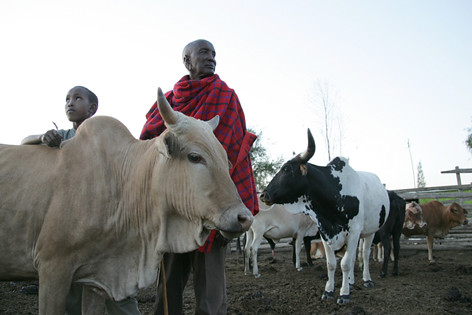Informal channels such as farmer to farmer interactions are more important sources of information on livestock production and marketing for rural farmers in Kenya than co-operative groups, government extension services and radio, a new study has found.
However, this farmer to farmer exchange is more popular among women farmers than among their male counterparts.
The study, published in the February 2012 edition of Livestock Research for Rural Development, assessed how women’s access to livestock information and financial services compares to that of men among male-headed rural households in four districts in Kenya: Kajiado, Kiambu, Meru and Tharaka.
The study also revealed gender disparities with respect to training of farmers in livestock production and marketing.
Men in male-headed households received more training on a greater variety of technical topics such as livestock breeding, health and marketing, whereas women mostly received training on general aspects of livestock management.
Trainings were mostly held within the village but outside the home.
“Increasing access to training by women will require holding training in venues that do not constrain women,” the authors suggest.
Gendered disparities were also observed in access to financial services.
Although both men and women relied on groups as their main source of credit, more men than women obtained credit from formal financial service providers such as banks, microfinance institutions and co-operative societies.
On the other hand, more women than men obtained credit from neighbours and friends.
For this reason, the authors recommend that “provision of credit facilities should be flexible and have consideration for women’s constrained access to collateral”.
Access the article
Citation
Mburu S, Njuki J and Kariuki J. 2012. Intra-household access to livestock information and financial services in Kenya. Livestock Research for Rural Development. Volume 24, Article #38. http://www.lrrd.org/lrrd24/2/mbur24038.htm
However, this farmer to farmer exchange is more popular among women farmers than among their male counterparts.
The study, published in the February 2012 edition of Livestock Research for Rural Development, assessed how women’s access to livestock information and financial services compares to that of men among male-headed rural households in four districts in Kenya: Kajiado, Kiambu, Meru and Tharaka.
The study also revealed gender disparities with respect to training of farmers in livestock production and marketing.
Men in male-headed households received more training on a greater variety of technical topics such as livestock breeding, health and marketing, whereas women mostly received training on general aspects of livestock management.
Trainings were mostly held within the village but outside the home.
“Increasing access to training by women will require holding training in venues that do not constrain women,” the authors suggest.
Gendered disparities were also observed in access to financial services.
Although both men and women relied on groups as their main source of credit, more men than women obtained credit from formal financial service providers such as banks, microfinance institutions and co-operative societies.
On the other hand, more women than men obtained credit from neighbours and friends.
For this reason, the authors recommend that “provision of credit facilities should be flexible and have consideration for women’s constrained access to collateral”.
Access the article
Citation
Mburu S, Njuki J and Kariuki J. 2012. Intra-household access to livestock information and financial services in Kenya. Livestock Research for Rural Development. Volume 24, Article #38. http://www.lrrd.org/lrrd24/2/mbur24038.htm


No comments:
Post a Comment